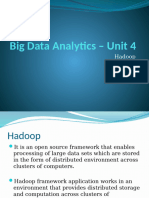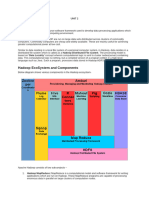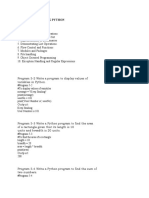Bigdata Unit IV
Bigdata Unit IV
Uploaded by
CS BCACopyright:
Available Formats
Bigdata Unit IV
Bigdata Unit IV
Uploaded by
CS BCAOriginal Title
Copyright
Available Formats
Share this document
Did you find this document useful?
Is this content inappropriate?
Copyright:
Available Formats
Bigdata Unit IV
Bigdata Unit IV
Uploaded by
CS BCACopyright:
Available Formats
UNIT IV HADOOP AND MAP REDUCE
UNIT IV
SYLLABUS:
Unit-4: HADOOP AND MAP REDUCE Hadoop: The
Hadoop Distributed File System Components of Hadoop Analysing the
Data with Hadoop Scaling Out Hadoop Streaming Design of HDFS
Java interfaces to HDFS Basics Developing a Map Reduce
Application How MapReduce Works Anatomy of a Map Reduce Job
run Failures Job Scheduling Shuffle and Sort Task execution Map
Reduce Types and Formats Map Reduce Features Hadoop
environment.
The Hadoop Distributed File System:
What is HDFS
Hadoop comes with a distributed file system called HDFS. In HDFS data is distributed
over several machines and replicated to ensure their durability to failure and high availability
to parallel application.
It is cost effective as it uses commodity hardware. It involves the concept of blocks,
data nodes and node name.
Hadoop File System was developed using distributed file system design. It is run on
commodity hardware. Unlike other distributed systems, HDFS is highly faulttolerant and
designed using low-cost hardware.
HDFS holds very large amount of data and provides easier access. To store such huge data,
the files are stored across multiple machines. These files are stored in redundant fashion to
rescue the system from possible data losses in case of failure. HDFS also makes applications
available to parallel processing.
Extremely large files: Here we are talking about the data in range of petabytes(1000 TB).
Streaming Data Access Pattern: HDFS is designed on principle of write-once and
read-many-times. Once data is written large portions of dataset can be processed any
number times.
Commodity hardware: Hardware that is inexpensive and easily available in the market.
This is one of feature which specially distinguishes HDFS from other file system.
Features of HDFS
It is suitable for the distributed storage and processing.
Hadoop provides a command interface to interact with HDFS.
P.SARITHA M.Sc.,M.Phil., PAGE 1
UNIT IV HADOOP AND MAP REDUCE
The built-in servers of namenode and datanode help users to easily check the status of
cluster.
Streaming access to file system data.
HDFS provides file permissions and authentication.
HDFS Architecture
Given below is the architecture of a Hadoop File System.
HDFS follows the master-slave architecture and it has the following elements.
Namenode
The namenode is the commodity hardware that contains the GNU/Linux operating system
and the namenode software. It is a software that can be run on commodity hardware. The
Manages the file system namespace.
It also executes file system operations such as renaming, closing, and opening files and
directories.
Datanode
The datanode is a commodity hardware having the GNU/Linux operating system and
datanode software. For every node (Commodity hardware/System) in a cluster, there will be a
datanode. These nodes manage the data storage of their system.
Datanodes perform read-write operations on the file systems, as per client request.
They also perform operations such as block creation, deletion, and replication according
to the instructions of the namenode.
P.SARITHA M.Sc.,M.Phil., PAGE 2
UNIT IV HADOOP AND MAP REDUCE
Block
Generally the user data is stored in the files of HDFS. The file in a file system will be
divided into one or more segments and/or stored in individual data nodes. These file segments
are called as blocks. In other words, the minimum amount of data that HDFS can read or write
is called a Block. The default block size is 64MB, but it can be increased as per the need to
change in HDFS configuration.
Goals of HDFS
Fault detection and recovery
Since HDFS includes a large number of commodity hardware, failure of components
is frequent. Therefore HDFS should have mechanisms for quick and automatic fault detection
and recovery.
Huge datasets
HDFS should have hundreds of nodes per cluster to manage the applications having
huge datasets.
Hardware at data
A requested task can be done efficiently, when the computation takes place near the
data. Especially where huge datasets are involved, it reduces the network traffic and increases
the throughput.
Portability
To facilitate adoption, HDFS is designed to be portable across multiple hardware
platforms and to be compatible with a variety of underlying operating systems.
HDFS DataNode and NameNode Image:
HDFS Read Image:
P.SARITHA M.Sc.,M.Phil., PAGE 3
UNIT IV HADOOP AND MAP REDUCE
HDFS Write Image:
Since all the metadata is stored in name node, it is very important. If it fails the file
system can not be used as there would be no way of knowing how to reconstruct the files from
blocks present in data node. To overcome this, the concept of secondary name node arises.
Secondary Name Node:
It is a separate physical machine which acts as a helper of name node. It performs
periodic check points.It communicates with the name node and take snapshot of meta data
which helps minimize downtime and loss of data.
P.SARITHA M.Sc.,M.Phil., PAGE 4
UNIT IV HADOOP AND MAP REDUCE
Features of HDFS
o Highly Scalable - HDFS is highly scalable as it can scale hundreds of nodes in a single
cluster.
o Replication - Due to some unfavorable conditions, the node containing the data may
be loss. So, to overcome such problems, HDFS always maintains the copy of data on a
different machine.
o Fault tolerance - In HDFS, the fault tolerance signifies the robustness of the system in
the event of failure. The HDFS is highly fault-tolerant that if any machine fails, the
other machine containing the copy of that data automatically become active.
o Distributed data storage - This is one of the most important features of HDFS that
makes Hadoop very powerful. Here, data is divided into multiple blocks and stored into
nodes.
o Portable - HDFS is designed in such a way that it can easily portable from platform to
another.
COMPONENTS OF HADOOP ANALYSING THE DATA WITH HADOOP
Building Blocks of Hadoop
1. HDFS (The storage layer)
As the name suggests, Hadoop Distributed File System is the storage layer of Hadoop
and is responsible for storing the data in a distributed environment (master and slave
configuration). It splits the data into several blocks of data and stores them across different data
nodes.
These data blocks are also replicated across different data nodes to prevent loss of data
when one of the nodes goes down.
It has two main processes running for processing of the data:
a. NameNode
It is running on the master machine. It saves the locations of all the files stored in the
file system and tracks where the data resides across the cluster i.e. it stores the metadata of the
files. When the client applications want to make certain operations on the data, it interacts with
the NameNode. When the NameNode receives the request, it responds by returning a list of
Data Node servers where the required data resides.
b. DataNode
This process runs on every slave machine. One of its functionalities is to store each
HDFS data block in a separate file in its local file system. In other words, it contains the actual
data in form of blocks. It sends heartbeat signals periodically and waits for the request from
the NameNode to access the data.
P.SARITHA M.Sc.,M.Phil., PAGE 5
UNIT IV HADOOP AND MAP REDUCE
2. MapReduce (The processing layer)
It is a programming technique based on Java that is used on top of the Hadoop
framework for faster processing of huge quantities of data. It processes this huge data in a
distributed environment using many Data Nodes which enables parallel processing and faster
execution of operations in a fault-tolerant way.
A MapReduce job splits the data set into multiple chunks of data which are further
converted into key-value pairs in order to be processed by the mappers. The raw format of the
data may not be suitable for processing. Thus, the input data compatible with the map phase is
generated using the InputSplit function and RecordReader.
InputSplit is the logical representation of the data which is to be processed by an
individual mapper. RecordReader converts these splits into records which take the form of key-
value pairs. It basically converts the byte-oriented representation of the input into a record-
oriented representation.
These records are then fed to the mappers for further processing the data. MapReduce
jobs primarily consist of three phases namely the Map phase, the Shuffle phase, and the Reduce
phase.
a. Map Phase
It is the first phase in the processing of the data. The main task in the map phase is to
process each input from the RecordReader and convert it into intermediate tuples (key-value
pairs). This intermediate output is stored in the local disk by the mappers.
The values of these key-value pairs can differ from the ones received as input from the
RecordReader. The map phase can also contain combiners which are also called as local
reducers. They perform aggregations on the data but only within the scope of one mapper.
As the computations are performed across different data nodes, it is essential that all
the values associated with the same key are merged together into one reducer. This task is
performed by the partitioner. It performs a hash function over these key-value pairs to merge
them together.
It also ensures that all the tasks are partitioned evenly to the reducers. Partitioners
generally come into the picture when we are working with more than one reducer.
b. Shuffle and Sort Phase
This phase transfers the intermediate output obtained from the mappers to the reducers.
This process is called as shuffling. The output from the mappers is also sorted before
transferring it to the reducers. The sorting is done on the basis of the keys in the key-value
pairs. It helps the reducers to perform the computations on the data even before the entire data
is received and eventually helps in reducing the time required for computations.
As the keys are sorted, whenever the reducer gets a different key as the input it starts to
perform the reduce tasks on the previously received data.
c. Reduce Phase
The output of the map phase serves as an input to the reduce phase. It takes these key-
value pairs and applies the reduce function on them to produce the desired result. The keys and
P.SARITHA M.Sc.,M.Phil., PAGE 6
UNIT IV HADOOP AND MAP REDUCE
the values associated with the key are passed on to the reduce function to perform certain
operations.
We can filter the data or combine it to obtain the aggregated output. Post the execution
of the reduce function, it can create zero or more key-value pairs. This result is written back in
the Hadoop Distributed File System.
3. YARN (The management layer)
Yet Another Resource Navigator is the resource managing component of Hadoop.
There are background processes running at each node (Node Manager on the slave machines
and Resource Manager on the master node) that communicate with each other for the allocation
of resources.
The Resource Manager is the centrepiece of the YARN layer which manages resources
among all the applications and passes on the requests to the Node Manager.
The Node Manager monitors the resource utilization like memory, CPU, and disk of
the machine and conveys the same to the Resource Manager. It is installed on every Data Node
and is responsible for executing the tasks on the Data Nodes.
SCALING OUT
Scale out is a growth architecture or method that focuses on horizontal growth, or the
addition of new resources instead of increasing the capacity of current resources (known as
scaling up). Ina system such as a cloud storage facility, following a scale-out growth would
mean that new storage hardware and controllers would be added in order to increase capacity.
This has two obvious pros one is that storage capacity is increased and the second is traffic
capacity is also increased because there is more hardware to share the load.
increases in the volume of data being produced and processed, many
databases are being overwhelmed with the deluge of data they are facing. To manage, store and
P.SARITHA M.Sc.,M.Phil., PAGE 7
UNIT IV HADOOP AND MAP REDUCE
organizations dealing with exploding datasets. A scalable data platform accommodates rapid
changes in the growth of data, either in traffic or volume. These platforms utilize added
hardware or software to increase output and storage of data. When a company has a scalable
data platform, it also is prepared for the potential of growth in its data needs.
Common Performance Bottlenecks
Companies should implement scalability into their organization precisely when performance
issues arise. These issues can negatively impact the workflow, efficiency and customer
retention. There are three common, key performance bottlenecks, that often point the way
toward a proper resolution with data scaling:
1. High CPU Usage is the most common bottleneck, and the most visible. Slowing and erratic
performance is a key indicator of high CPU usage, and can often be a harbinger of other issues.
User CPU means the CPU is doing productive work, but needs a server upgrade; system CPU
refers to usage consumed by the operating system, and is usually related to the software; and
I/O wait, which is the idling time caused by the CPU waiting for the I/O subsystem.
2. Low Memory is the next most common bottleneck. Servers without enough memory to handle
an application load can slow the application completely. Low memory can require a RAM
upgrade, but this can also be an indicator of a memory leak, which requires finding and
3. High Disk Usage is another common bottleneck. This is often caused by maxed out disks, and
is a huge indicator of the need for a data scale.
Scaling Up vs. Scaling Out
Once a decision has been made for data scaling, the specific scaling approach must be chosen.
There are two commonly used types of data scaling, up and out:
P.SARITHA M.Sc.,M.Phil., PAGE 8
UNIT IV HADOOP AND MAP REDUCE
1. Scaling up, or vertical scaling, involves obtaining a faster server with more powerful
processors and more memory. This solution uses less network hardware, and consumes less
power; but ultimately, for many platforms may only provide a short-term fix, especially if
continued growth is expected.
2. Scaling out, or horizontal scaling, involves adding servers for parallel computing. The scale
out technique is a long-term solution, as more and more servers may be added when needed.
But going from one monolithic system to this type of cluster may be a difficult, although
extremely effective solution.
-eye view
of the system and look at the data flow for large inputs. For simplicity, the examples so far
have used files on the local filesystem. However, to scale out, we need to store the data in a
Hadoop to mov
see how this works.
Data Flow
First, some terminology. A MapReduce job is a unit of work that the client wants to be
performed: it consists of the input data, the MapReduce program, and configuration
information. Hadoop runs the job by dividing it into tasks, of which there are two types: map
tasks and reduce tasks.
There are two types of nodes that control the job execution process: a jobtracker and a number
of tasktrackers. The jobtracker coordinates all the jobs run on the system by scheduling tasks
to run on tasktrackers. Tasktrackers run tasks and send progress reports to the jobtracker, which
keeps a record of the overall progress of each job. if a task fails, the jobtracker can reschedule
it on a different tasktracker.
Hadoop divides the input to a MapReduce job into fixed-size pieces called input splits, or just
splits. Hadoop creates one map task for each split, which runs the userdefined map function for
each record in the split.
Having many splits means the time taken to process each split is small compared to the time to
process the whole input. So if we are processing the splits in parallel, the processing is better
P.SARITHA M.Sc.,M.Phil., PAGE 9
UNIT IV HADOOP AND MAP REDUCE
load-balanced if the splits are small, since a faster machine will be able to process
proportionally more splits over the course of the job than a slower machine. Even if the
machines are identical, failed processes or other jobs running concurrently make load balancing
desirable, and the quality of the load balancing increases as the splits become more fine-
grained.
On the other hand, if splits are too small, then the overhead of managing the splits and of map
task creation begins to dominate the total job execution time. For most jobs, a good split size
tends to be the size of an HDFS block, 64 MB by default, although this can be changed for the
cluster (for all newly created files), or specified when each file is created.
Hadoop does its best to run the map task on a node where the input data resides in HDFS. This
is called the data locality optimization. It should now be clear why the optimal split size is the
same as the block size: it is the largest size of input that can be guaranteed to be stored on a
single node. If the split spanned two blocks, it would be unlikely that any HDFS node stored
both blocks, so some of the split would have to be transferred across the network to the node
running the map task, which is clearly less efficient than running the whole map task using
local data.
Map tasks write their output to the local disk, not to HDFS. Why is this? Map output is
job is complete the map output can be thrown away. So storing it in HDFS, with replication,
would be overkill. If the node running the map task fails before the map output has been
consumed by the reduce task, then Hadoop will automatically rerun the map task on another
node to re-create the map output.
f data locality the input to a single reduce task is
normally the output from all mappers. In the present example, we have a single reduce task that
is fed by all of the map tasks. Therefore, the sorted map outputs have to be transferred across
the network to the node where the reduce task is running, where they are merged and then
passed to the user-defined reduce function. The output of the reduce is normally stored in HDFS
for reliability. As explained in Chapter The Hadoop Disrtibuted Fle Systemfor each HDFS
block of the reduce output, the first replica is stored on the local node, with other replicas being
P.SARITHA M.Sc.,M.Phil., PAGE 10
UNIT IV HADOOP AND MAP REDUCE
stored on off-rack nodes. Thus, writing the reduce output does consume network bandwidth,
but only as much as a normal HDFS write pipeline consumes.
The whole data flow with a single reduce task is illustrated in Figure The dotted boxes indicate
nodes, the light arrows show data transfers on a node, and the heavy arrows show data transfers
between nodes.
The number of reduce tasks is not governed by the size of the input, but is specified
reduce tasks for a given job.
When there are multiple reducers, the map tasks partition their output, each creating one
partition for each reduce task. There can be many keys (and their associated values) in each
partition, but the records for any given key are all in a single partition. The partitioning can be
controlled by a user-defined partitioning function, but normally the default partitioner which
buckets keys using a hash function works very well.
The data flow for the general case of multiple reduce tasks is illustrated in Figure This diagram
makes it clear why the data flow between map and reduce tasks is coll
P.SARITHA M.Sc.,M.Phil., PAGE 11
UNIT IV HADOOP AND MAP REDUCE
this diagram suggests, and tuning it can have a big impact on job execution time, as you will
need the shuffle since the processing can be carried out entirely in parallel (a few examples are
-node data transfer is when the
map tasks write to HDFS (see Figure ).
Combiner Functions
Many MapReduce jobs are limited by the bandwidth available on the cluster, so it pays to
minimize the data transferred between map and reduce tasks. Hadoop allows the user to specify
a
to the reduce function. Since the combiner function is an optimization, Hadoop does not
provide a guarantee of how many times it will call it for a particular map output record, if at
all. In other words, calling the combiner function zero, one, or many times should produce the
same output from the reducer
P.SARITHA M.Sc.,M.Phil., PAGE 12
UNIT IV HADOOP AND MAP REDUCE
The contract for the combiner function constrains the type of function that may be used. This
is best illustrated with an example. Suppose that for the maximum temperature example,
readings for the year 1950 were processed by two maps (because they were in different splits).
Imagine the first map produced the output:
1.(1950, 0)
2.(1950, 20)
3.(1950, 10)
And the second produced:
(1950, 25)
(1950, 15)
The reduce function would be called with a list of all the values:
1 (1950, [0, 20, 10, 25, 15])
P.SARITHA M.Sc.,M.Phil., PAGE 13
UNIT IV HADOOP AND MAP REDUCE
with output:
(1950, 25)
since 25 is the maximum value in the list. We could use a combiner function that, just like the
reduce function, finds the maximum temperature for each map output. The reduce would then
be called with:
(1950, [20, 25])
and the reduce would produce the same output as before. More succinctly, we may express the
function calls on the temperature values in this case as follows:
max(0, 20, 10, 25, 15) = max(max(0, 20, 10), max(25, 15)) = max(20, 25) = 25
Not all function
mean(0, 20, 10, 25, 15) = 14
but:
mean(mean(0, 20, 10), mean(25, 15)) = mean(10, 20) = 15
The
is still needed to process records with the same key from different maps.) But it can help cut
down the amount of data shuffled between the maps and the reduces, and for this reason alone
P.SARITHA M.Sc.,M.Phil., PAGE 14
UNIT IV HADOOP AND MAP REDUCE
it is always worth considering whether you can use a combiner function in your MapReduce
job.
Specifying a combiner function
Going back to the Java MapReduce program, the combiner function is defined using the
Reducer interface, and for this application, it is the same implementation as the reducer
function in MaxTemperatureReducer. The only change we need to make is to set the combiner
class on the JobConf (see Example ).
Example . Application to find the maximum temperature, using a combiner function for
efficiency
public class MaxTemperatureWithCombiner {
public static void main(String[] args) throws IOException {
if (args.length != 2) {
System.err.println("Usage: MaxTemperatureWithCombiner <input path> " +
"<output path>");
System.exit(-1);
P.SARITHA M.Sc.,M.Phil., PAGE 15
UNIT IV HADOOP AND MAP REDUCE
JobConf conf = new JobConf(MaxTemperatureWithCombiner.class);
conf.setJobName("Max temperature");
10
FileInputFormat.addInputPath(conf, new Path(args[0]));
11
FileOutputFormat.setOutputPath(conf, new Path(args[1]));
12
conf.setMapperClass(MaxTemperatureMapper.class);
13
conf.setCombinerClass(MaxTemperatureReducer.class);
14
conf.setReducerClass(MaxTemperatureReducer.class);
15
conf.setOutputKeyClass(Text.class);
16
conf.setOutputValueClass(IntWritable.class);
17
P.SARITHA M.Sc.,M.Phil., PAGE 16
UNIT IV HADOOP AND MAP REDUCE
JobClient.runJob(conf);
18
19
Aggregation Operator Generalizing Group-By, Cross-Tab, and Sub-
Running a Distributed MapReduce Job The same program will run, without alteration, on a full
dataset. This is the point of MapReduce: it scales to the size of your data and the size of your
-node EC2 cluster running High-CPU Extra Large
Instances, the program took six minutes to run.
HADOOP STREAMING
Hadoop provides an API to MapReduce that allows you to write your map and reduce functions
in languages other than Java. Hadoop Streaming uses Unix standard stream as the interface
between Hadoop and your program, so you can use any language that can read standard input
and write to standard output to write your MapReduce program.
Streaming is naturally suited for text processing (although, as of version 0.21.0, it can handle
binary streams, too), and when used in text mode, it has a line-oriented view of data. Map input
data is passed over standard input to your map function, which processes it line by line and
writes lines to standard output. A map output key-value pair is written as a single tab-delimited
line. Input to the reduce function is in the same format a tab-separated key-value pair passed
over standard input. The reduce function reads lines from standard input, which the framework
guarantees are sorted by key, and writes its results to standard output.
ng our MapReduce program for finding maximum temperatures
by year in Streaming.
P.SARITHA M.Sc.,M.Phil., PAGE 17
UNIT IV HADOOP AND MAP REDUCE
Ruby
The map function can be expressed in Ruby as shown in Example
Example Map function for maximum temperature in Ruby
#!/usr/bin/env ruby
STDIN.each_line do |line|
val = line
year, temp, q = val[15,4], val[87,5], val[92,1]
puts "#{year}t#{temp}" if (temp != "+9999" && q =~ /[01459]/)
end
This is a factor of seven faster than the serial run on one machine using awk. The main reason
convenience, the input files were gzipped by year, resulting in large files for later years in the
dataset, when the number of weather records was much higher.
The program iterates over lines from standard input by executing a block for each line from
STDIN (a global constant of type IO). The block pulls out the relevant fields from each input
line, and, if the temperature is valid, writes the year and the temperature separated by a tab
character t to standard output (using puts).
The Java API is geared toward processing your map function one record at a time. The
framework calls the map() method on your Mapper for each record in the input, whereas with
Streaming the map program can decide how to process the input for example, it could easily
possible to consider multiple lines at a time by accumulating previous lines in an instance
P.SARITHA M.Sc.,M.Phil., PAGE 18
UNIT IV HADOOP AND MAP REDUCE
variable in the Mapper.§ In this case, you need to implement the close() method so that you
know when the last record has been read, so you can finish processing the last group of lines.
using Hadoop, simply using Unix pipes:
% cat input/ncdc/sample.txt | ch02/src/main/ruby/max_temperature_map.rb
1950 +0000
1950 +0022
1950 -0011
1949 +0111
1949 +0078
The reduce function shown in Example is a little more complex.
Example . Reduce function for maximum temperature in Ruby
#!/usr/bin/env ruby
last_key, max_val = nil, 0
P.SARITHA M.Sc.,M.Phil., PAGE 19
UNIT IV HADOOP AND MAP REDUCE
STDIN.each_line do |line|
key, val = line.split("t")
if last_key && last_key != key
puts "#{last_key}t#{max_val}"
last_key, max_val = key, val.to_i
else
last_key, max_val = key, [max_val, val.to_i].max
10
end
11
end
12
puts "#{last_key}t#{max_val}" if last_key
P.SARITHA M.Sc.,M.Phil., PAGE 20
UNIT IV HADOOP AND MAP REDUCE
13
Again, the program iterates over lines from standard input, but this time we have to
store some state as we process each key group. In this case, the keys are weather station
identifiers, and we store the last key seen and the maximum temperature seen so far for that
key. The MapReduce framework ensures that the keys are ordered, so we know that if a key is
different from the previous one, we have moved into a new key group. In contrast to the Java
API, where you are provided an iterator over each key group, in Streaming you have to find
key group boundaries in your program.
For each line, we pull o
&& last_key != key), we write the key and the maximum temperature for that group, separated
just finished a group, we just update the maximum temperature for the current key.
The last line of the program ensures that a line is written for the last key group in the
input.
We can now simulate the whole MapReduce pipeline with a Unix pipeline (which is
equivalent to the Unix pipeline shown in Figure ):
% cat input/ncdc/sample.txt | ch02/src/main/ruby/max_temperature_map.rb |
sort | ch02/src/main/ruby/max_temperature_reduce.rb
1949 111
P.SARITHA M.Sc.,M.Phil., PAGE 21
UNIT IV HADOOP AND MAP REDUCE
1950 22
The output is the same as the Java program, so the next step is to run it using Hadoop itself.
Streaming JAR file along with the jar option. Options to the Streaming program specify the
input and output paths, and the map and reduce scripts. This is what it looks like:
% hadoop jar $HADOOP_INSTALL/contrib/streaming/hadoop-*-streaming.jar -input
input/ncdc/sample.txt
-output output
-mapper ch02/src/main/ruby/max_temperature_map.rb
-reducer ch02/src/main/ruby/max_temperature_reduce.rb
When running on a large dataset on a cluster, we should set the combiner, using the -
combiner option.
From release 0.21.0, the combiner can be any Streaming command. For earlier releases,
the combiner had to be written in Java, so as a workaround it was common to do manual
combining in the mapper, without having to resort to Java. In this case, we could change the
mapper to be a pipeline:
% hadoop jar $HADOOP_INSTALL/contrib/streaming/hadoop-*-streaming.jar
P.SARITHA M.Sc.,M.Phil., PAGE 22
UNIT IV HADOOP AND MAP REDUCE
-input input/ncdc/all
-output output
-mapper "ch02/src/main/ruby/max_temperature_map.rb | sort |
ch02/src/main/ruby/max_temperature_reduce.rb"
-reducer ch02/src/main/ruby/max_temperature_reduce.rb -file
ch02/src/main/ruby/max_temperature_map.rb
-file ch02/src/main/ruby/max_temperature_reduce.rb
Note also the use of -file, which we use when running Streaming programs on the cluster to
ship the scripts to the cluster.
Python
Streaming supports any programming language that can read from standard input, and
example
again. The map script is in Example and the reduce script is in Example
Example . Map function for maximum temperature in Python
#!/usr/bin/env python
P.SARITHA M.Sc.,M.Phil., PAGE 23
UNIT IV HADOOP AND MAP REDUCE
import re
import sys
for line in sys.stdin:
val = line.strip()
(year, temp, q) = (val[15:19], val[87:92], val[92:93])
if (temp != "+9999" and re.match("[01459]", q)):
print "%st%s" % (year, temp)
Example 2-11. Reduce function for maximum temperature in Python
10
#!/usr/bin/env python
11
import sys
P.SARITHA M.Sc.,M.Phil., PAGE 24
UNIT IV HADOOP AND MAP REDUCE
12
(last_key, max_val) = (None, 0)
13
for line in sys.stdin:
14
(key, val) = line.strip().split("t")
15
if last_key and last_key != key:
16
print "%st%s" % (last_key, max_val)
17
(last_key, max_val) = (key, int(val))
18
else:
19
(last_key, max_val) = (key, max(max_val, int(val)))
20
if last_key:
21
print "%st%s" % (last_key, max_val)
P.SARITHA M.Sc.,M.Phil., PAGE 25
UNIT IV HADOOP AND MAP REDUCE
As an alternative to Streaming, Python programmers should consider Dumbo , which
makes the Streaming MapReduce interface more Pythonic and easier to use.
We can test the programs and run the job in the same way we did in Ruby. For example,
to run a test:
% cat input/ncdc/sample.txt | ch02/src/main/python/max_temperature_map.py |
sort | ch02/src/main/python/max_temperature_reduce.py
1949 111
1950 22
DESIGN OF HDFS
When a dataset outgrows the storage capacity of a single physical machine, it becomes
necessary to partition it across a number of separate machines. Filesystems that manage the
storage across a network of machines are called distributed file systems
Hadoop comes with a distributed filesystem called HDFS, which stands for Hadoop
Distributed Filesystem.
The Design of HDFS :
HDFS is a filesystem designed for storing very large files with streaming data access
patterns, running on clusters of commodity hardware.
Very large files:
terabytes in size. There are Hadoop clusters running today that store petabytes of data.
Streaming data access :
P.SARITHA M.Sc.,M.Phil., PAGE 26
UNIT IV HADOOP AND MAP REDUCE
HDFS is built around the idea that the most efficient data processing pattern is a write-
once, readmany-times pattern. A dataset is typically generated or copied from source, then
various analyses are performed on that dataset over time.
Commodity hardware :
run on clusters of commodity hardware (commonly available hardware available from multiple
vendors3) for which the chance of node failure across the cluster is high, at least for large
clusters.
HDFS is designed to carry on working without a noticeable interruption to the user in
the face of such failure.
These are areas where HDFS is not a good fit today:
Low-latency data access :
Applications that require low-latency access to data, in the tens of milliseconds range,
will not work well with HDFS.
Lots of small files :
Since the name node holds file system metadata in memory, the limit to the number of
files in a file system is governed by the amount of memory on the name node.
Multiple writers, arbitrary file modifications:
Files in HDFS may be written to by a single writer. Writes are always made at the end
of the file. There is no support for multiple writers, or for modifications at arbitrary offsets in
the file.
HDFS Concepts Blocks:
HDFS has the concept of a block, but it is a much larger unit 64 MB by default. Files
in HDFS are broken into block-sized chunks, which are stored as independent units.
Having a block abstraction for a distributed filesystem brings several benefits.:
The first benefit :
the blocks from a file to be stored on the same disk, so they can take advantage of any of the
disks in the cluster.
Second:
Making the unit of abstraction a block rather than a file simplifies the storage
subsystem. The storage subsystem deals with blocks, simplifying storage management (since
blocks are a fixed size, it is easy to calculate how many can be stored on a given disk) and
eliminating metadata concerns.
Third:
P.SARITHA M.Sc.,M.Phil., PAGE 27
UNIT IV HADOOP AND MAP REDUCE
Blocks fit well with replication for providing fault tolerance and availability. To insure
against corrupted blocks and disk and machine failure, each block is replicated to a small
number of physically separate machines (typically three).
Why Is a Block in HDFS So Large?
HDFS blocks are large compared to disk blocks, and the reason is to minimize the cost
of seeks. By making a block large enough, the time to transfer the data from the disk can be
made to be significantly larger than the time to seek to the start of the block. Thus the time to
transfer a large file made of multiple blocks operates at the disk transfer rate.
A quick calculation shows that if the seek time is around 10 ms, and the transfer rate is
100 MB/s, then to make the seek time 1% of the transfer time, we need to make the block size
around 100 MB. The default is actually 64 MB, although many HDFS installations use 128
MB blocks. This figure will continue to be revised upward as transfer speeds grow with new
generations of disk drives.
Name nodes and Data nodes:
An HDFS cluster has two types of node operating in a master-worker pattern: a
namenode (the master) and a number of datanodes (workers). The namenode manages the
filesystem namespace. It maintains the filesystem tree and the metadata for all the files and
directories in the tree. This information is stored persistently on the local disk in the form of
two files: the namespace image and the edit log. The name node also knows the data nodes on
which all the blocks for a given file are located.
Apache Hadoop is designed to have Master Slave architecture:
Master: Namenode, JobTracker
Slave: {DataNode, TaskTrac cker}
P.SARITHA M.Sc.,M.Phil., PAGE 28
UNIT IV HADOOP AND MAP REDUCE
HDFS is one primary components of Hadoop cluster and HDFS is designed to
have Master-slave architecture.
Master: Name Node
- The Master (Name Node) manages the file system namespace operations like opening,
closing, and renaming files and directories and determines the mapping of blocks to Data Nodes
along with regulating access to files by client.
- Slaves (DataNodes)
clients along with perform block creation, deletion, and replication upon instruction from the
Master (NameNode).
Data nodes are the workhorses of the filesystem. They store and retrieve blocks when they are
told to (by clients or the namenode), and they report back to the namenode periodically with
lists of blocks that they are storing.
NameNode failure: if the machine running the namenode failed, all the files on the filesystem
would be lost since there would be no way of knowing how to reconstruct the files from the
blocks on the datanodes.
P.SARITHA M.Sc.,M.Phil., PAGE 29
You might also like
- Linux Cheat Sheet Sponsored by LogglyDocument1 pageLinux Cheat Sheet Sponsored by LogglyDinesh Sathiyamoorthy100% (1)
- HADOOP FRAME WORKDocument38 pagesHADOOP FRAME WORKvinaybiradar14No ratings yet
- Fbda Unit-3Document27 pagesFbda Unit-3Aruna ArunaNo ratings yet
- Big Data Analytics – Unit 4Document32 pagesBig Data Analytics – Unit 4Prabha JoshiNo ratings yet
- BDA NotesDocument25 pagesBDA Notesmrudula.sbNo ratings yet
- BDA-Unit 4Document20 pagesBDA-Unit 4vazhmuniNo ratings yet
- CC Unit 5Document43 pagesCC Unit 5prassadyashwinNo ratings yet
- 4 UNIT-4 Introduction To HadoopDocument154 pages4 UNIT-4 Introduction To HadoopPrakashRameshGadekarNo ratings yet
- Introduction To HadoopDocument5 pagesIntroduction To HadoopHanumanthu GouthamiNo ratings yet
- Unit-2 Hadoop HDFS HadoopecosystemDocument25 pagesUnit-2 Hadoop HDFS Hadoopecosystemsisodiyaa853No ratings yet
- HADOOPDocument19 pagesHADOOPucebittrichy2020No ratings yet
- Lovely Professional University (Lpu) : Mittal School of Business (Msob)Document10 pagesLovely Professional University (Lpu) : Mittal School of Business (Msob)FareedNo ratings yet
- Top Hadoop Interview Q&ADocument25 pagesTop Hadoop Interview Q&AP vishnuNo ratings yet
- Unit II Big DataDocument27 pagesUnit II Big Datarohitmarale77No ratings yet
- Apache Hadoop: Developer(s) Stable Release Preview ReleaseDocument5 pagesApache Hadoop: Developer(s) Stable Release Preview Releasenitesh_mpsNo ratings yet
- Unit-2 Introduction To HadoopDocument19 pagesUnit-2 Introduction To HadoopSivaNo ratings yet
- Cloud ComputingDocument19 pagesCloud ComputingAfia FaryadNo ratings yet
- Unit 3Document18 pagesUnit 3Ajay Kumar KanamarlapudiNo ratings yet
- Unit IiDocument39 pagesUnit Ii021- IMRANNo ratings yet
- Compare Hadoop & Spark Criteria Hadoop SparkDocument18 pagesCompare Hadoop & Spark Criteria Hadoop Sparkdasari ramyaNo ratings yet
- BDA Lab Assignment 3 PDFDocument17 pagesBDA Lab Assignment 3 PDFparth shahNo ratings yet
- Big Data Analytics AssignmentDocument7 pagesBig Data Analytics AssignmentDevananth A BNo ratings yet
- BiG DaTaDocument9 pagesBiG DaTaSoumyajit Basu100% (1)
- HadoopDocument4 pagesHadoopscribd.unguided000No ratings yet
- DSBDA ORAL Question BankDocument6 pagesDSBDA ORAL Question BankSUnny100% (1)
- Big Data Lecture PresentationDocument28 pagesBig Data Lecture Presentationzioncalvin9No ratings yet
- Unit 4 - Data Science - Www.rgpvnotes.inDocument18 pagesUnit 4 - Data Science - Www.rgpvnotes.inDSyncNo ratings yet
- BDA Unit-3Document47 pagesBDA Unit-3Jaya PrakashNo ratings yet
- Act2 - March7 - 6E - BDA - SECDocument8 pagesAct2 - March7 - 6E - BDA - SECyadukrishnagiriworkNo ratings yet
- Bda Summer 2022 SolutionDocument30 pagesBda Summer 2022 SolutionVivekNo ratings yet
- HadoopDocument5 pagesHadoopVaishnavi ChockalingamNo ratings yet
- BigData Fundamental and Hadoop Interview QuestionsDocument33 pagesBigData Fundamental and Hadoop Interview QuestionsBabumoshaiNo ratings yet
- UNIT 5 CombinedDocument13 pagesUNIT 5 Combinedparidhiagarwal129No ratings yet
- 02 Unit-II Hadoop Architecture and HDFSDocument18 pages02 Unit-II Hadoop Architecture and HDFSKumarAdabalaNo ratings yet
- Wa0001.Document56 pagesWa0001.Lakkarsu PoojithaNo ratings yet
- Efficient Ways To Improve The Performance of HDFS For Small FilesDocument5 pagesEfficient Ways To Improve The Performance of HDFS For Small FilesYassine ZriguiNo ratings yet
- Unit 2 Big Data NotesDocument21 pagesUnit 2 Big Data Notespahadesunanda17No ratings yet
- Module-2-Introduction To HDFS and ToolsDocument38 pagesModule-2-Introduction To HDFS and ToolsshreyaNo ratings yet
- CS19741-Cloud Computing-Unit 3 NotesDocument37 pagesCS19741-Cloud Computing-Unit 3 NotesRahul Chiranjeevi VNo ratings yet
- Unit 3Document15 pagesUnit 3xcgfxgvxNo ratings yet
- Unit - IIDocument64 pagesUnit - IIpraneelp2000No ratings yet
- Unit 3Document61 pagesUnit 3Ramstage TestingNo ratings yet
- Unit IIIDocument86 pagesUnit IIIFarhan SjNo ratings yet
- Big DataDocument16 pagesBig Dataroushan singhNo ratings yet
- HADOOP ECOSSYTEM, COMPONENTS, Loading, Getting Data From HadoopDocument10 pagesHADOOP ECOSSYTEM, COMPONENTS, Loading, Getting Data From HadoopKunal TejwaniNo ratings yet
- BDA Lab Assignment 2Document18 pagesBDA Lab Assignment 2parth shahNo ratings yet
- Hadoop Ecosystem PDFDocument6 pagesHadoop Ecosystem PDFKittuNo ratings yet
- Unit-2 - Introduction To Hadoop and Hadoop ArchitectureDocument46 pagesUnit-2 - Introduction To Hadoop and Hadoop Architecture21dce011No ratings yet
- Features of HDFSDocument2 pagesFeatures of HDFSsampathaboNo ratings yet
- Bda Unit 2Document21 pagesBda Unit 2245120737162No ratings yet
- Big Data Importance of Hadoop Distributed FilesystemDocument4 pagesBig Data Importance of Hadoop Distributed FilesystemLuis VásquezNo ratings yet
- PDF Bigdata 15cs82 Vtu Module 1 2 NotesDocument17 pagesPDF Bigdata 15cs82 Vtu Module 1 2 NotesrajuNo ratings yet
- Hadoop Unit-4Document44 pagesHadoop Unit-4Kishore ParimiNo ratings yet
- bda final sem 7Document120 pagesbda final sem 7himanshidvyasNo ratings yet
- Hadoop Interview1Document27 pagesHadoop Interview1paramreddy2000No ratings yet
- IMTC634_Data Science_Chapter 14Document22 pagesIMTC634_Data Science_Chapter 14msmakkar.chief19No ratings yet
- Hadoop Major ComponentsDocument10 pagesHadoop Major ComponentsaswagadaNo ratings yet
- Hadoop File SystemDocument2 pagesHadoop File SystemAradhana HingneNo ratings yet
- Wa0002.Document32 pagesWa0002.Lakkarsu PoojithaNo ratings yet
- Hadoop Distributed File SystemDocument3 pagesHadoop Distributed File SystemAkhila ShajiNo ratings yet
- e CommerceDocument3 pagese CommerceCS BCANo ratings yet
- UNIT 3Document11 pagesUNIT 3CS BCANo ratings yet
- QUESTION BANK FOR III CS (MC)Document10 pagesQUESTION BANK FOR III CS (MC)CS BCANo ratings yet
- Robotics (Sandhiya S)Document31 pagesRobotics (Sandhiya S)CS BCANo ratings yet
- Unit 4Document31 pagesUnit 4CS BCANo ratings yet
- FILE HANDLING 8th PROGRAMDocument3 pagesFILE HANDLING 8th PROGRAMCS BCANo ratings yet
- PythonDocument77 pagesPythonCS BCANo ratings yet
- Artificial Intelligence (Roselin)Document38 pagesArtificial Intelligence (Roselin)CS BCANo ratings yet
- Unit 5Document68 pagesUnit 5CS BCANo ratings yet
- Lab 3Document5 pagesLab 3CS BCANo ratings yet
- R ProgramDocument2 pagesR ProgramCS BCANo ratings yet
- Python ProgramDocument24 pagesPython ProgramCS BCANo ratings yet
- DWDM Unit-2Document20 pagesDWDM Unit-2CS BCANo ratings yet
- Python Var IdentDocument7 pagesPython Var IdentCS BCANo ratings yet
- Unit 3 BdaDocument9 pagesUnit 3 BdaVINAY AGGARWALNo ratings yet
- Debian ReferenceDocument184 pagesDebian ReferenceLucio D'AmeliaNo ratings yet
- Unity Family 5 3 1 RN - en UsDocument18 pagesUnity Family 5 3 1 RN - en Usajgonzal3640No ratings yet
- ATI2016WD Userguide en-USDocument88 pagesATI2016WD Userguide en-USSaravanan SNo ratings yet
- Hadoop: The Definitive Guide Unit 2 Part 2: Hadoop I/ODocument26 pagesHadoop: The Definitive Guide Unit 2 Part 2: Hadoop I/OPrem KumarNo ratings yet
- CDD Scanning GuideDocument15 pagesCDD Scanning GuideKundan KadamNo ratings yet
- Linux Commands With ExamplesDocument18 pagesLinux Commands With Examplesjannu januNo ratings yet
- Mako Documentation: Release 1.0.8Document106 pagesMako Documentation: Release 1.0.8ShrishKunjaruNo ratings yet
- 3 CS ServicesandCallDocument31 pages3 CS ServicesandCallhasnaatdon1No ratings yet
- IBM FileNet P8 Prerequisite Skills 4Document171 pagesIBM FileNet P8 Prerequisite Skills 4Thiago Correia Medeiros100% (1)
- ActualTests LPI 117-101 v03 29 04Document68 pagesActualTests LPI 117-101 v03 29 04Anonymous WXvywZqJNo ratings yet
- Archiving Process in Sales DistributionDocument26 pagesArchiving Process in Sales DistributionkishorepanchakarlaNo ratings yet
- Linux Flashcards QuizletDocument11 pagesLinux Flashcards QuizletZiaNo ratings yet
- SSPC Inst Usr Guide-V11Document104 pagesSSPC Inst Usr Guide-V11venkatrangan2003No ratings yet
- IPFS Based Solution For Secure File StorageDocument6 pagesIPFS Based Solution For Secure File StorageInternational Journal of Innovative Science and Research TechnologyNo ratings yet
- A Quick Step by Step Guide For Oracle 11g R2 Installation On Red Hat Enterprise Linux 5Document6 pagesA Quick Step by Step Guide For Oracle 11g R2 Installation On Red Hat Enterprise Linux 5Rakesh KumarNo ratings yet
- History Design Principles Programmer Interface User Interface Process Management Memory Management File System I/O System Interprocess CommunicationDocument62 pagesHistory Design Principles Programmer Interface User Interface Process Management Memory Management File System I/O System Interprocess CommunicationFarooq ShadNo ratings yet
- Sprite File System: © Jeff Parker, 2004Document21 pagesSprite File System: © Jeff Parker, 2004sushmsnNo ratings yet
- Linux Hands On SolutionDocument35 pagesLinux Hands On SolutionTejaswi SowmyaNo ratings yet
- Introduction To HDFSDocument25 pagesIntroduction To HDFSabhics8050426993No ratings yet
- Netapp CommandsDocument4 pagesNetapp Commandsmanas199No ratings yet
- Sapmnt /hana/shared/: File System Default Path RecommendationsDocument3 pagesSapmnt /hana/shared/: File System Default Path RecommendationsDerrick DayNo ratings yet
- Oracle Unified and Internet DirectoryDocument7 pagesOracle Unified and Internet DirectoryRahul SharmaNo ratings yet
- Nbu 100 Scl (1) UpdatedDocument91 pagesNbu 100 Scl (1) UpdatedAmin AnwarNo ratings yet
- RH124 DDDDDocument2 pagesRH124 DDDDlinux.hamdyNo ratings yet
- Introduction To Hadoop EcosystemDocument46 pagesIntroduction To Hadoop EcosystemGokul J LNo ratings yet
- White Paper - Best Practices For Data Replication With EMC Isilon SyncIQDocument33 pagesWhite Paper - Best Practices For Data Replication With EMC Isilon SyncIQaminekiNo ratings yet
- Module V - System AdministrationDocument23 pagesModule V - System AdministrationChitreshh BanerjeeNo ratings yet
- S1000-007 SamDocument11 pagesS1000-007 Samjeet pandaNo ratings yet







































































































